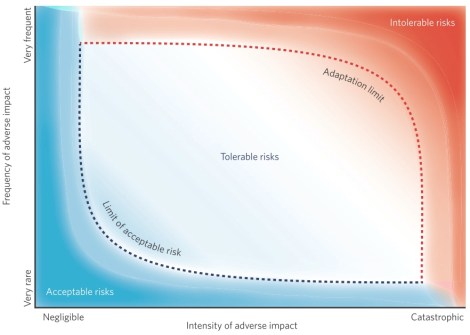Presidential science advisor John Holdren is fond of saying that there are only three possible responses to climate change: mitigation, adaptation, and suffering. We’ll prevent what we can, adjust to what we can’t prevent, and suffer through what we can’t adjust to. All that remains is to determine the proportions.
Lots of people are averse to large-scale suffering. But lots of people are also averse to substantial mitigation measures. This leaves them placing a great deal of faith in adaptation. Just based on conversations I’ve had over the years, I think there are lots of people who are vaguely aware of climate change, convinced that something is really happening, but who have a kind of free-floating confidence in human beings’ ability to adjust to circumstances. Adjusting is what we do — humans live in just about every kind of microclimate the planet offers, after all. If climate zones shift or move around, we’ll get used to it. Why break the bank trying to prevent something that we can just learn to live with?
Now, on the merits, this is crazy. Our best understanding is that preventing (mitigating) a degree of global temperature rise is much, much cheaper than adapting to it. Compared to adaptation, mitigation is a huge bargain, whether you’re measuring by money, time, disruption, ecosystem integrity, whatever.
But still, people have an extremely deep-seated faith in adaptation. What’s odd is that, as much as we talk about it, as much as we trust in it, we don’t have a very good understanding of its dynamics or its limits. It remains, in popular discussions of climate policy, a kind of unexamined deus ex machina.
A new commentary in Nature Climate Change attempts to move the ball forward a little by offering an analytical framework for thinking about adaption. The key insight is that human adaptation is an intrinsically social process, so the most salient limits on adaptation may be social rather than biophysical or economic. However, the authors note …
… little is known about limits in social systems — whether there are social limits to adaptation, what influences their likelihood, where these might lie, who they would affect and what the consequences of reaching such limits might be.
To help start exploring those questions, the authors introduce a framework for thinking about social adaptation. It is an “actor-centered, risk-based approach,” which means that it begins by asking how individuals assess the risks they face. The authors draw on previous research showing that …
… actors will implicitly or explicitly place risks to their valued objectives into one of three categories involving different types of response: acceptable risks are risks deemed so low that further efforts in risk reduction (adaptation) are not justified; tolerable risks relate to situations where adaptive, risk-reduction efforts are required for risks to be kept within reasonable levels; and intolerable risks are those which fundamentally threaten a private or social norm — threatening, for instance, public safety, continuity of traditions, a legal standard or a social contract — despite adaptive action having been taken. On reaching an intolerable risk level, we normally expect a discontinuity of behaviour in order to avoid the risk, whether this is a homeowner’s decision to move, or a forester selling off land, as the alternative is increasing losses. The question of what is acceptable, tolerable or intolerable remains with the individual actors, as they shape collective responses. [my emphasis]
So: as individuals, we do nothing as long as risks are acceptable. When they cross from acceptable to tolerable, we begin taking adaptive action. And when they cross from tolerable to intolerable, we exhibit “discontinuity of behavior,” which is a dry, antiseptic way of describing what are often acts of desperation — abandoning, fleeing, migrating — that end in radically diminished quality of life.
Here’s a kind of map of risk perception, with frequency of bad stuff as the vertical axis and severity of bad stuff as the horizontal axis:

Nature Climate ChangeClick to embiggen.
One interesting thing about this framework: in the case of extremely frequent or extremely severe risks, we quickly reach the limits of adaptation; the distance between acceptable risk and intolerable risk is quite small. In other words, if we face bad things happening very frequently, or very bad things happening, there’s very little space for adaptation. It is in that wide swath in the middle, the mid-frequency, mid-severity impacts, that adaptation will take place.
So think about, for instance, Superstorm Sandy. As it is, it seems barely to have bumped NYC into seeing climate change as a tolerable risk, i.e., something to take adaptive action on. Try to imagine, now, what it would take to bump it over the line to intolerable risk — what it would take to cause people to start abandoning coastal areas of NYC. How frequent would storms have to be? How severe?
The authors begin with an example of individual risk assessment in the form of a rice farmer in South Asia. Rice yield declines 10 percent with every degree of nighttime temperature over 26 degrees C. There are near-term adaptive responses that can cushion the blow as temperature rises, but at a certain point, profitable rice farming becomes impossible. Facing intolerable risk, the farmer sells or abandons the farm.
Things get more complicated at the social or cultural level, where such individual responses are aggregated. The authors cite, as a cultural example, the mid- to late-15th century Norse Greenland society, which was around for about 400 years before … it wasn’t. They adapted and adapted to the “Little Ice Age” until finally they faced too many pressures, couldn’t adapt any more, and went bye-bye.
It’s interesting to imagine the internal discussions among the Norse Greenlanders. Surely some found the risks tolerable — i.e., were advocating action — while others still found them acceptable. And surely some found them intolerable — were unable to maintain their own practices and lifestyles — while others still found them tolerable. Different individuals assess risk differently. And crucially, debates over what is acceptable vs. tolerable vs. intolerable risk can slow collective responses.
There’s also a rather obvious point to make here about equity, though the authors do not make it. The members of a society with the most economic or political power will also be the ones most buffered against risk. As the last to be adversely affected by risks, they will be the least inclined to take adaptive action, especially if it’s expensive. And because they are also the ones with the most political influence, they will be able to delay collective action even as risks are ravaging the more vulnerable.
To put the point more bluntly: The 1 percent can delay adaptive action even when the 99 percent are suffering. By the time the 1 percent are swayed to action, the risks to the broader collective may already have become intolerable. Thus do the social limits of adaptation bite harder, and faster, than any physical or economic limits.
We badly need further research into these areas, to help us understand individual limits to adaptation and how they aggregate into social limits on adaptation. Only then can we accurately forecast the impacts of climate change. “Identifying ‘dangerous climate change’,” the authors write, “relies on understanding which actors will be affected and whether they are facing adaptation limits.”
Many communities in vulnerable regions like the Arctic are already bumping up against the limits of adaptation. More and more communities, regions, and economic sectors will do the same as climate change accelerates in coming decades. “Researchers need to begin making progress in predicting and anticipating adaptation limits,” the authors conclude, “and policymakers need to start making plans for managing the consequences of exceeding adaptation limits.”
Yup.



